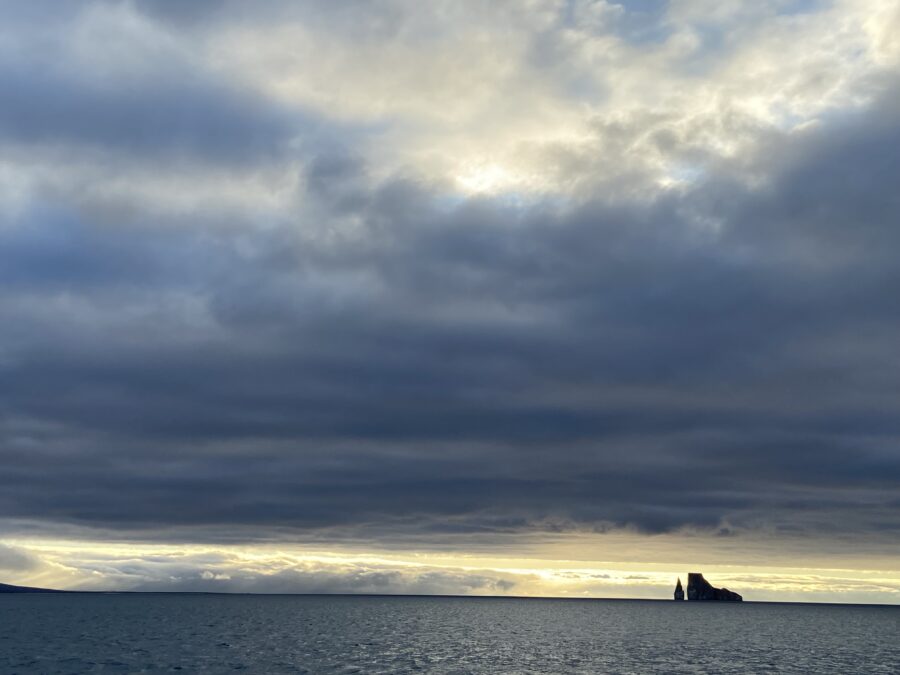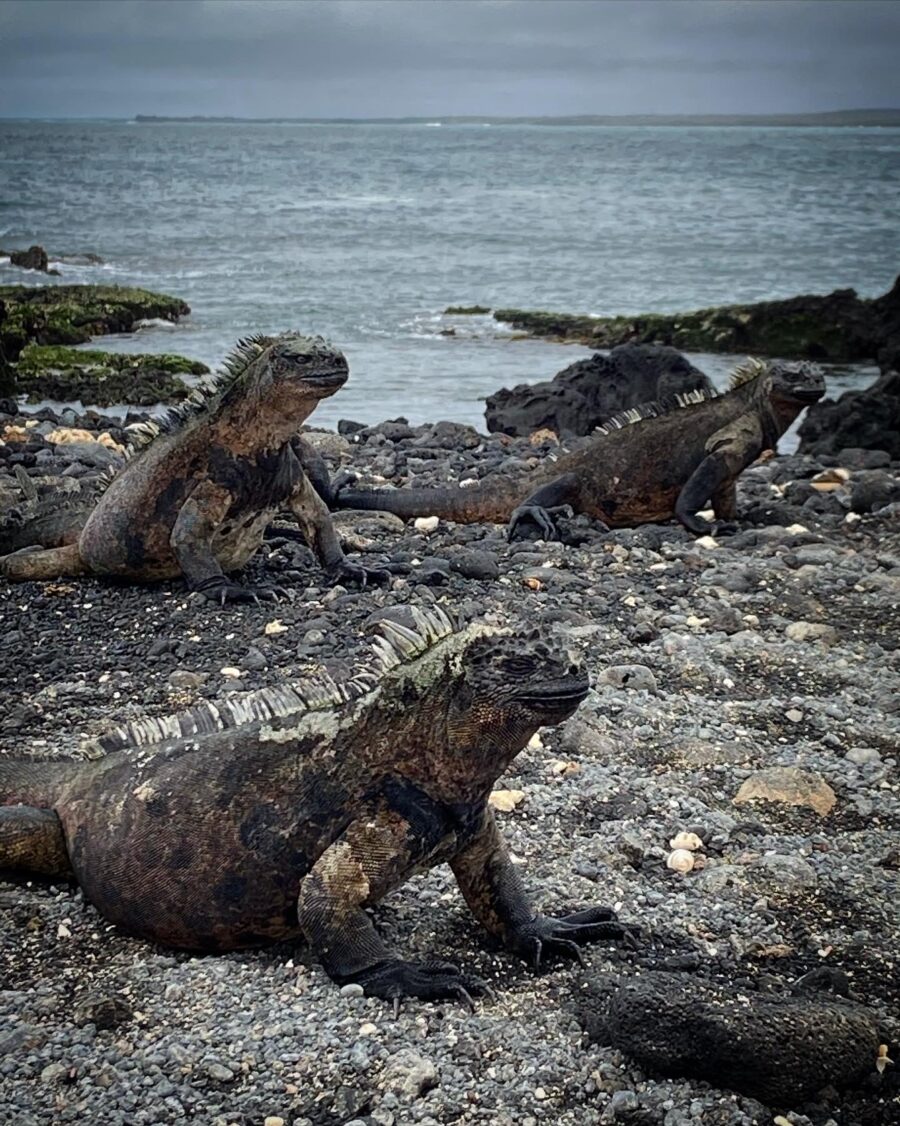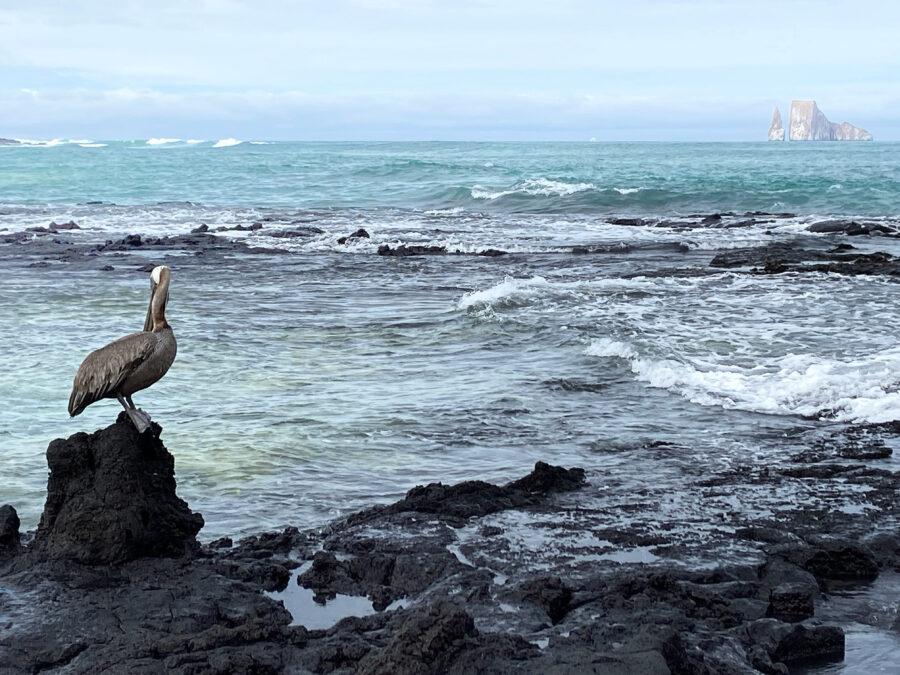Galápagos
I would even walk upside down
About 1200 kilometres separate the Galápagos Islands from mainland Ecuador. They are far from everything, and it is not possible to get there by ferry. From Quito, I take the first flight, which takes about an hour and stops in Guayaquil for 45 minutes and then continues for about 2.5 hours before landing at Seymour airport on the island of Baltra. As soon as we land, the stewardesses spray a disinfectant spray against insects that we may have brought with us from the mainland: this is the first proactive action taken to protect the biodiversity that awaits me outside the fuselage.
The doors open and immediately I see my first iguanas. They sit in the sun, peaceful and undisturbed, while we disembark. As I wait to pay the entry fee (USD 100 in 2022, payable only in cash) some Darwin finches fly overhead. At that very moment I feel even more deeply that one of my greatest dreams as a traveller is about to come true: I have arrived in a time capsule, in a living laboratory of inestimable value to scientists all over the planet.
It is estimated that 95 per cent of the species inhabiting these islands are original endemics. Seymour Airport, for example, is carbon-neutral: the building is powered solely by solar and wind energy and 80% of its infrastructure is made from materials recycled from the old building. It even has mechanical dampers that open and close according to the building’s heat and CO2 levels. Fresh water comes from the airport’s desalination plant, which converts local seawater.

The greatest threat to the fragile Galápagos ecosystem is the introduction of invasive species. Ecuador has therefore instituted a series of biosecurity protocols for people like me arriving by plane: for example, all luggage must pass through a very thorough screening process during which authorities check for live plants, seeds, and animals to ensure that non-endemic species are not transported – sometimes inadvertently – to the islands. I am then asked to walk through a solution that sterilises the soles of my shoes.
For me, travelling responsibly also means seriously complying with such procedures. But I can admit with you that I would have acceded to any request from the Ecuadorean authorities to enter this time bubble: I would have gladly walked upside down if it had been a requirement for entry!
Disconnecting to connect
Before moving on to the real tale of wonders in the Galápagos, I thought I would leave you here a series of tips and aspects to consider in case you were thinking of a little trip to this part of the world:
- You cannot do as you please. You cannot just get on a boat at random, wander as you like from island to island. You have to take part in one of the cruises (yes, they are called that) that are organised by multiple agencies that you will find once you arrive either on Baltra Island (where I arrived), or at the San Cristobal airport. This type of organisation is a mandatory procedure that allows humanity arriving in the Galápagos not to destroy this delicate ecosystem. Deal with it.
- During the entire cruise, mobile phones do not work, EVER, I must emphasise. There is no Wi-Fi on board. Communicate this to whoever is waiting for you at home, if necessary. You are in the middle of nowhere. It is said that here you disconnect to connect. Connect with yourself, with nature, with a present in which biological rhythms seem to be re-emerging fast. If you are addicted to Instagram, Facebook, Tiktok or whatever, go elsewhere. The noise of the world cannot get here. Far from being constantly online, you will be reminded or, depending on how young you are, learn for the first time that it is still possible to spend your evenings playing cards, reading, or simply sitting in silence looking at a horizon that never ends here, or marvelling every time the frigates fly over the boat and accompany you for many kilometres.
- Cruises – guided by certified biologists – may last a week and may even cost more than what you would spend on twenty days in mainland Ecuador. If you have to/want to spend little, go elsewhere.7
- Cruises do not always follow the same route. To ensure that not too many people and not too many boats all crowd onto the same island and thus disturb (or worse, damage) the animals and plants that inhabit it, each cruise will follow its own itinerary, decided by the crew and biologists who will accompany you on this adventure. So don’t get hung up on necessarily wanting to see this island or that one. Here you count as the two of spades. If you are a control freak, go elsewhere.
- You cannot even decide what to cook or when to eat. Meals on the boats have a very regular schedule: breakfast at 7 a.m., lunch at 12 p.m., dinner at 7 p.m. The food you are lucky enough to taste is incredible and varied, with vegetarian options practically every day, or at least that’s how it was for me. You are not a star chef. Just relax and enjoy everything the crew will prepare for you.

- When you see iguanas, sea lions, not to mention turtles and penguins, but also when white sharks come wandering around your boat (especially at night), do not shout, do not use flashes, and above all do not approach or touch the animals. Sounds like obvious advice, doesn’t it? Yet, believe me: in my adventure there was a great need to remind myself of this necessity over and over again.
- The boats on which you will spend at least a week are – in general – quite small. To give you an example, I am 1.80m tall. Between the top of my skull and the ceiling of the cabin – which I gladly shared with one of the best travel friends one can have – there were very few centimetres. The cabin consisted of two bunk beds: I slept on the top floor. Between my face and the ceiling, again, there were very few centimetres. We also had a bathroom: it included a toilet, a microscopic sink, and a shower that was also very small. If you suffer from claustrophobia, go elsewhere. If you are travelling with someone you don’t get along with, apart from being crazy, do some soul-searching before you leave. It could end badly.

- The Galápagos are in the middle of the Pacific Ocean. Too bad this expanse of water is often anything but serene. The first evening, after dining in a quiet area, we immediately set sail and sailed through the night. During the first half-hour in the cabin I thought I had made a huge miscalculation: everything was dancing, stomach, head, legs, let’s put it that way. But then I went to bed and a miracle happened: from that night on, the nausea passed and I slept all the time. You will say: ‘OK, but so what, who cares’. No, you should know that I don’t sleep much or well, but in the midst of the most aggressive waves, I slept a lot and well and deeply. Lie down when you are in the cabin. Hold on tight to the edges of the boats when you sail through this mostly uninhabited paradise. Don’t be heroes. You are not Danny Boodmann T.D. Lemon Novecento or even Captain Ahab.

- On some islands, the boat may approach the coast. In other cases, you will have to board a dinghy (or on richer cruises, a small boat). The naturalist guide, however, will tell you the programme for the next day and inform you about the type of landing that awaits you. He will tell you about dry landing when you could use socks and shoes without worrying about getting them wet. If, on the other hand, you hear the terms wet landing, it means that either you can jump without shoes into the water (for me it never went above the knee), or you might want to wear sandals or waterproof footwear. Listen to the guide. They know exponentially more about this ecosystem than you do.
